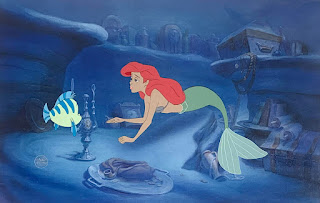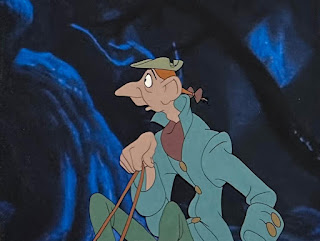Original hand painted production animation cel of Edgar, Scat Cat, and the Alley Cats (Shun Gon the Chinese Cat, Hit Cat the English Cat, and Peppo the Italian Cat) from "The Aristocats," 1970, Walt Disney Studios; Set on a lithographic background; Size - Edgar & Cats: 7 x 6 3/4", Image: 11 x 10"; Unframed.
To purchase this cel or to visit the Art Gallery, CLICK HERE!
To purchase this cel or to visit the Art Gallery, CLICK HERE!
"The
Aristocats," 1970 is an animated feature film produced and released by
Walt Disney Productions. This was the last film project to be approved
by Walt Disney himself, as he died in late 1966, before the film was
finally released to theaters by Buena Vista Distribution on December 11,
1970. "The Aristocats" featured the voice talent of Eva Gabor, Hermione
Baddeley, Phil Harris, Dean Clark, Sterling Holloway, Scatman Crothers,
and Roddy Maude-Roxby.
The
film is based on a story by Tom McGowan and Tom Rowe, and centers
around a family of aristocratic cats. After the mistress's butler
kidnaps them (to gain his mistress' fortune which was intended to go to
the cats) an unlikely alley cat acquaintance helps them escape and be
returned to their home.
It is Paris 1910 and Madame
Bonfamille tells her lawyer Georges Hautecourt that she has decided to
leave all of her stocks, bonds, mansion, treasures, jewels, and her
entire fortune to her beloved cats rather than to her butler, Edgar
Balthazar. When Edgar overhears this he fears the cats will outlive
him, and that he will never see a penny of the inheritance. He then
realizes that he has to get rid of the cats; "I'll be gone, no oh no...
they'll be gone," he says. Edgar decides to put sleeping tablets into
the cats milk and when they fall asleep, he takes them in a covered
basket on his motorcycle far away from the city of Paris.
Scat Cat is the leader of the musical group the Alley Cats composed of Shun Gon the Chinese Cat, Hit Cat the English Cat, Billy Boss the Russian Cat, and Peppo the Italian Cat. Scat Cat was originally named Satchmo Cat and was intended to be voiced
by Louis Armstrong; unfortunately he became ill and was unable to follow
through with the project. The replacement was Scatman Crothers, the
character was renamed Scat Cat, and the song "Everybody Wants To Be A
Cat" was written for him. It is worth noting that Scat Cat still retains
the Louis Armstrong musical instrument of choice, the trumpet.
The song "Everybody Wants To Be A Cat" was written by Al Rinker and Floyd Huddleston, is the last song in "The Aristocats" and is sung by Scatman Crothers as Scat Cat, Phil Harris as Thomas O'Malley, Thurl Ravenscroft as Bill Boss the Russian Cat, Robie Lester as Duchess, and Liz English as Marie. The lines that were sung by Shun Gon the Chinese cat, voiced by Paul Winchell, have been removed as they are now viewed as politically incorrect.
The song "Everybody Wants To Be A Cat" was written by Al Rinker and Floyd Huddleston, is the last song in "The Aristocats" and is sung by Scatman Crothers as Scat Cat, Phil Harris as Thomas O'Malley, Thurl Ravenscroft as Bill Boss the Russian Cat, Robie Lester as Duchess, and Liz English as Marie. The lines that were sung by Shun Gon the Chinese cat, voiced by Paul Winchell, have been removed as they are now viewed as politically incorrect.
The character of Edgar was voiced by Roddy Maude-Roxby, an accomplished English actor. He was just wonderful in the role with the delightful snooty English butler voice, that could also morph into a scheming cunning timber perfect for a Disney Villain. This is a spectacular image of Edgar, Scat Cat, and the Alley Cats (Shun Gon the Chinese Cat, Hit Cat the English Cat, and Peppo the Italian Cat) as they try and stop Edgar from shipping Madame Bonfamille's cats to Timbuktu! A very action packed image and this would be a great addition to any animation art collection!
#TheAristocats #Aristocats #Disney #WaltDisney #cel #animation #animationcel #animationdrawing #productioncel #productiondrawing #Duchess #ThomasOMalley #OMalley #OllieJohnston #MiltKahl #untitledartgallery #cats #PhilHarris #EvaGabor #Marie #Berlioz #Toulouse #AndreasDeja #FrankThomas #RobieLester #HermioneBaddeley #DeanClark #SterlingHolloway #ScatmanCrothers #RoddyMaudeRoxby #TomMcGowan #TomRowe #AbrahamDeLaceyGiuseppeCaseyThomasOMalley #Napoleon #Lafayette #PatButtram #GeorgeLindsey












